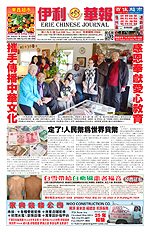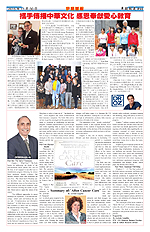|
|
|
|
克城消息
|
| |
|
|
|
|
|
|
攜手傳播中華文化 感恩奉獻愛心敎育
|
 |
|
|
|
|
|
今天是感恩節,雖然他們與我們膚色長相不同,但他們與你我一樣,有着一顆愛中華的心,他們是貢獻文化與敎育的人。我感恩生命中遇到過的每一個人。無論是我的親人,還是朋友,甚至只是一面之緣,愛心和寬容組成了我們的生活點滴。這個世界就是這么有魅力,沒有人會無緣無故在你生命中出現。每一個在你生命里出現的人,都有甚深的因緣。愛你的人給了你感動,你愛的人讓你學會奉獻,感恩節里,感恩爲中華文化敎育奉獻的人! |
|
|
|
|
|
|
|
|
.JPG) |
|
|
|
Dr.Vilma Seeberg & (Jack) John J. Craciun III |
|
我認識(Jack) John J. Craciun
III已經有五年多了,因爲他是一個地地道道的美國人,70年代去了中國, 70年代中國太窮,許多地方還沒有旅店,Jack
他可以與中國的老人睡在同一個床上,五年來他一直在爲中國龍找一個“家”,他的夢想要這條中國龍走進世界,最近我帶了一位來自中國的訪問學者蕭學良先生去認識(Jack)
John J. Craciun III,第一次的相認,蕭先生吿訴了他的感想:
當我走進杰克的工作室的那一瞬間,讓我深深地感受到了濃鬱的中國文化充滿了整個屋子,墻壁上的6副中國書法和中國的國畫及書桌上的那支大大的毛筆深深地吸引了我。還有那些相框里與中國八十年的一線明星的合影,更加體會到他與中國人民的友好和對中國文化的熱愛。一位七十多歲的老人,精神矍鑠,神采奕奕的映襯出年輕時不乏分流倜儻及現在的多才多藝。自信,樂觀,正能量全寫在他的臉上。作爲一位深深愛着自己國家的中國人,我對這位美國老人在這一瞬間不由産生一種敬佩與崇敬之情。也更加堅定我去做一位普通的中美兩國民間文化,敎育交流的使者。
五年來,Jack做了許多學習與硏究,在他的身邊有過許多才華橫溢的人,有的留下了有的走了,當然留走都是有原因。今年感恩節我帶了Jack
和目前就讀George Washington University 的Antwain Thomas一起去參加了The 10th
Annual Seeberg-Jacobs Thanksgiving Morning Pie &
Coffee。在那里他們相互交流,交流的內容離不開中華文化。
ITM總裁Jack感謝我讓他們認識一對對中國有着深厚感情的夫婦。
讓Dr.Vilma Seeberg與Jack Craciun認識,是因爲他們心里都裝着中華的文化與敎育,這是創辦伊利報紙的眞正目的,給更多想傳承宣傳中華文化的人提供一個交流的機會。Dr.Vilma
Seeberg親自做的Pie 讓ITM總裁Jack Craciun十分激動,他説:今天他再次品嚐到他奶奶做的Pie味道。
.jpg)
.jpg)
Dr.Vilma Seeberg對中國有着一份獨特的情懷,她熱愛中國,
她自己是12歲從德國到美國來讀書,後來她想留在美國繼續深造。她從事敎育,于1979年第一次去中國講課,那個時候她就希望能幫助中國,幫助那些偏僻貧窮地區的孩子,讓他們受敎育。她2000年在中國陝西設立了觀蘭奬學金基金會,
專門幫助貧窮女生接受敎育。先生Tom Jacobs從事了35年的新聞工作。他倆在18年前在中國領養了一個女孩,現在女兒也上了Kent
State University,他們明年暑假將再去中國。
Dr.Vilma Seeberg心想讓更多的中國女孩有機會受敎育,Jack心想着中國震撼的龍走進世界。
.jpg)
ITM 與伊利華報已經合作了5年“第一火龍”項目,我非常理解也明白ITM爲什么要做這“第一火龍”,那是因爲ITM總裁Jack
Craciun的父親在70年代就説了:未來的世界是東方。Jack一個出生在美國的第三代人,他帶着夢想在中國創業了20年。
2010“第一火龍”正式啓動,2015年年底將“第一火龍” 全球中華文化傳播交流新聞發佈,並做産品介紹及知識産權申請活動。ITM
5年的第一條龍基金會也創立了,目的就是弘揚淵遠流長的中華文化,因爲龍早在猶太基督敎文化誕生千年之前就已存在,ITM集團將宣傳中國這條龍,他們將承擔第一個在世界面前展現中華文化誕生與發展的重任。
在感恩節里,華人身處異國,我感恩Dr.Vilma Seeberg和ITM總裁Jack Craciun,他們心系中華,關心中國文化與敎育。
.JPG)
以下是中國陝西的觀蘭奬學金基金會網站www.guanlanscholarshipfoundation.org,通過網站,您可以更加瞭解Vilma
Seeberg和Tom Jacobs,請您支持中國的敎育事業。同時也希望您能關注網站www.itmltd.com 做更多的瞭解。
ITM 1984年成立于香港,公司目前主要項目是娛樂敎育與醫學,最近,第一條龍基金會的懂事之一- Dr. Dwight McKee
新書After Cancer Care剛剛出爐,我也在電話採訪了- Dr. Dwight McKee ,本月還安排了著名醫生OZ
,下次一起刋登採訪文章。
|
.jpg) |
|
|
|
|
|
|
|
|
|
|
.jpg) |
Summary of:“After
Cancer Care”
By: Lorinda Laughlin
.jpg)
本文作者:Lorinda Laughlin
Part One: The End of Treatment
Chapter 1: “What Now?” The book begins by addressing the plight of
the post-treatment cancer patient who, 95% of the time, is not
engaged in any after-care or rehabilitation program following his
release from treatment, despite evidence that lifestyle changes made
after treatment can save lives. The initial relief of beating
cancer, therefore, turns into fear, uncertainty and debilitating
stress as the patient has no action plan for post cancer treatment,
other than anxiously awaiting the results of periodic blood tests to
signal the return of his cancer.
Two different approaches to cancer treatment are explained:
“Conventional Oncology,” which seeks and destroys the cancer, and
“Complementary and Alternative Medicine” (CAM) which seeks to
increase host resistance to tumor cells by changing the internal
terrain of the body.
Chapters 2 – 3: The reader is offered explanations as to why his
oncologist has offered little in the way of post-conventional
treatment, including a lack of education, and adherence to specific
protocols prescribed by the National Comprehensive Cancer Network
and the American Society of Clinical Oncology in order to keep out
of “uncharted waters,” avoid litigation and insure reimbursement
from insurance companies. The book offers advice on how to get the
oncologist and the general practitioner to cooperate in establishing
an after-care program. Valuable practical advice is given in
specific terms regarding what to expect in terms of post-treatment
testing, such as blood tests, x-rays and scans, and the reader is
coached in how to prepare for follow-up visits with the oncologist
and how to keep a CA Rehab journal which outlines strategies in the
areas of nutrition, exercise, detoxification and life balance.
Part Two: Physical Health
“Remission is something like the proverb in which a grandfather
tells his grandson that all people have two wolves raging inside
them. One wolf is kindness and one is hate. The grandson asks which
wolf will win, and the grandfather answers: the one you feed.”
(After Cancer Care, p. 39)
Chapter 4: Part Two begins with an explanation of the principle of “Epigenetics,”
in which genes respond to the external stimuli of food toxins,
environment, stress and exercise by either suppressing or promoting
the increase of enzyme and protein production which, in turn,
drastically affects wellness. Epigenetics may trigger a cell to
become either a cancerous cell or a “natural killer” cell which will
work to eliminate cancer cells. Feeding the natural killer cell with
healthy lifestyle changes will better equip it to eliminate the CA
cell. In the alternative, feeding the CA cell with a diet high in
inflammatory products, little exercise and stress will make it the
winner.
The importance of the “grossly overlooked” lymphatic system is also
explored because of its importance in the creation of degenerative
disease and, alternately, in the decrease of the development of
chronic inflammation which can lead to cell mutation and cancer.
Chapter 5: The role of obesity, sedentary lifestyle and food
chemistry in facilitating CA growth is explained, and specific
instruction is given on what to eat and why (i.e. what are the
specific chemical effects on the body), what foods to avoid, how to
shop for and prepare food and when to eat it.
The book next discusses the use of nutritional
supplements(micronutrients, phytonutrients and herbs) and explores
why we should use them, the reasons why studies don’t always show
their effectiveness, and how they are absorbed in various parts of
the body. Specific nutritional supplements and their dosages are
given for treating residual symptoms from chemotherapy, including
peripheral neuropathy, cardiomyopathy and “chemo-brain,” and there
is a special section on the benefits of Vitamin D.
Chapter 6: This chapter on exercise explains the relationship of
obesity and activity levels to cancer recurrence. Exercises specific
to the CA patient are outlined and include cardio workouts,
resistance training and stretching, along with advice on how to get
motivated and started on an exercise program.
Chapter 7 outlines common and lesser known internal and external
toxins and discusses how one should approach the confusing mass of
available data regarding the carcinogenic potential of tested
chemicals (which represent only a fraction of the 80,000 chemical
substances to which we are exposed.) Specific advice is given on how
to avoid these toxins, how to detox the home, and cook safely.
Chapter 8 gives treatment protocols for each of 9 major types of CA
(breast, colon, prostate, lung, lymphedema, melanoma, renal,
leukemia and thyroid). Each protocol outlines basic facts, causes
and contributing factors, relevant diagnostic testing, definitions
of each level in the cancer staging system, nutritional supplement
programs with explanations and dosages, dietary action plans and
lifestyle interventions.
Part Three: Emotional Well Being
Chapters 9 – 12: This final section of the book explores emotional
well-being and addresses stress and mental health as real physical
conditions. It explains how Western medicine has historically
separated emotional issues from physical health even though research
shows stress can weaken the immune system and facilitate the
metastatic process. The book outlines stress management techniques
such as yoga, “heartmath,” meditation and guided imagery and gives
further guidance in how to seek out a social support system, and how
to create a new definition of a balanced life in mind, body and
spirit.
The conclusion of the book contains a “Quick Hot List” of 28
lifestyle changes to reduce the risk of CA recurrence along with 34
recipes. The book is also interspersed throughout with personal
stories from cancer patients.
Prepared by:
Ms. Lorinda Laughlin,
ITM (US) Domestic Business Development & Culture Research Advisor
.jpg)
本書作者:Dwight -nb
|
|
|

 |
|
|
|
|
|
|
|
|
|
|
|
|
|
|
|
|
|
|
|
|
|
|
|
|
|
|
|
|
|
|
|
|
|
|
|
|
|
|
|
|
|
|
|
|
|
|
|
|
|
|
|
|
|
|
|
|
|
|
|
|
|
|
|
|
|
|
|
|
|
|
|
|
|
|
|
|
|
|
|
|
|
|
|
|
|
|
|
|
|
|
| |
| |
|
|